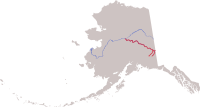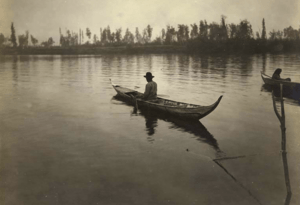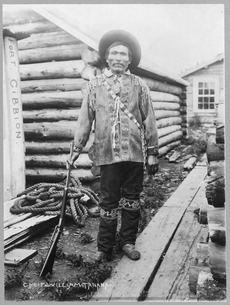Tanana Athabaskans facts for kids
 
Tanana River and Lower Tanana Athabaskan fish camp in the Chena, Alaska, June 1997.
|
|
| Total population | |
|---|---|
|
|
| Regions with significant populations | |
| United States (Alaska) (majority); Canada (Yukon) (minority) |
|
| Languages | |
| Upper Tanana language, Lower Tanana language, American English (Alaskan variant), | |
| Religion | |
| Shamanism (largely ex), Christianity |
The Tanana Athabaskans are a group of Native Alaskan people. They speak languages from the Athabaskan family. These people originally lived along the Tanana River in east-central Interior Alaska. A small group also lived in Yukon, Canada.
In their own languages, they are called different names. For example, in Lower Tanana and Koyukon, they are called Ten Hʉt'ænæ, meaning 'trail people'. In Gwich'in, they are Tanan Gwich'in, meaning 'people of Tanana River'.
There are three main groups of Tanana Athabaskans, based on their languages:
- Lower Tanana (also called Tanana proper or Middle Tanana)
- Tanacross (or Tanana Crossing)
- Upper Tanana
The Tanana Athabaskans traditionally lived by hunting and gathering. Their society followed a matrilineal system, meaning family lines are traced through the mother. They were also semi-nomadic, moving between different camps depending on the season. They hunted animals like moose, caribou, and Dall sheep. They also trapped smaller animals.
Their neighbors were other Athabaskan-speaking groups. These included the Koyukon to the north, Gwichʼin to the northeast, and Ahtna to the south.
Contents
Tanana Family Groups
The land where the Tanana Athabaskan people lived can be split into four main areas. These include the uplands and lowlands around the Tanana River.
The Goodpaster River acts like a natural border. It separates the groups who speak Tanacross and Upper Tanana languages (upriver) from those who speak Lower and Middle Tanana languages (downriver).
Tanana Athabaskans have a special way of organizing their families called a matrilineal kinship system. This means children belong to their mother's family group, or "clan." The most important social unit was the "local band," which was a family or hunting group. These small groups, usually 20–40 people, would move together. They had a main winter camp and several smaller camps for hunting and fishing. They moved in a cycle, following the seasons and where food was available.
At the end of the 1800s, there were twelve main groups living in the Tanana Athabaskan area. Six were "downriver" groups (four Lower Tanana and two Middle Tanana). The other six were "upriver" groups (two Tanacross and four Upper Tanana).
Lower Tanana Groups
These groups spoke the Lower Tanana language:
- Minto band: Lived in the Minto Flats area.
- Nenana-Toklat band: Lived near the Nenana River and Toklat River.
- Wood River band: Lived in the Wood River area.
- Chena band: Lived near the Chena River and Chena Village (and formerly Fairbanks).
Middle Tanana Groups
These groups spoke a dialect of Lower Tanana, which some people consider a separate language.
- Salcha(ket) band: Lived near the Salcha River.
- Delta-Goodpaster band: Lived near Big Delta and the Goodpaster River.
Tanacross Groups
These groups spoke the Tanacross language:
- Healy River-Joseph band: Lived near Healy Lake.
- Mansfeld-Kechumstuk band: Lived near Tanacross and Dot Lake.
Upper Tanana Groups
These groups spoke the Upper Tanana language:
- Tetlin-Last Tetlin band: Lived near Tetlin.
- Lower Nabesna band: Lived near Northway and the lower Nabesna River.
- Scottie Creek band: Lived near Scottie Creek, partly in Alaska and partly in Canada (known as White River First Nation).
- Upper Nabesna-Upper Chisana band: Lived in the upper Nabesna River and Chisana River areas.
Ancient History
Archaeological sites in Alaska show some of the earliest signs of people in North America. The interior of Alaska has been lived in for about 12,000 to 14,000 years. This area was not covered by ice during the last Ice Age. This created a path between the Bering Land Bridge (which connected Asia and North America) and the rest of North America.
Scientists believe that the ancestors of the Athabaskan people have lived in this region for a very long time. Tools made of chipped stone, similar to those found in Siberia, have been discovered here.
Archaeologists divide the ancient history of Interior Alaska into three main periods:
Paleo-Arctic Tradition
This period was from about 12,000 to 6,000 years ago. It refers to the first people who settled across Alaska. In Interior Alaska, this tradition included two main groups: the Nenana and Denali complexes.
Nenana Complex
The Nenana complex started around 11,000 years ago. Many sites from this time are found in the Tanana Valley. Examples include Broken Mammoth and Swan Point.
Denali Complex
The Denali complex dates from about 10,500 to 8,000 years ago. Sites like Swan Point also show signs of the Denali complex. Around 8,000 years ago, the boreal forest (a type of northern forest) grew in Interior Alaska.
In 2013, the remains of two babies were found near the Tanana River. They are about 11,500 years old. These are the oldest human remains found in the North American Arctic and Subarctic regions.
Northern Archaic Tradition
This tradition was strong from 6,000 to 1,000 years ago. More people lived in Interior Alaska during this time. This period is known for the appearance of special stone tools called side-notched projectile points.
Athabascan Tradition
The Athabaskan tradition flourished from 1,300 to 800 years ago. Language studies suggest that Athabaskan culture might have appeared in the Tanana Valley as early as 2,500 years ago.
We know a lot about Athabaskan culture from stories, traditions, and artifacts. These artifacts include tools made from bone and antler, fishhooks, beads, and birch bark trays. In the Upper Tanana area, people also used native copper to make tools and ornaments. This copper was often traded from the Ahtna people.
Athabaskan people moved around a lot. Their settlements depended on where they could find food. They lived a nomadic life, meaning they moved from place to place.
Recent History
Historians divide the recent history of Alaskan Natives into four periods:
- Early Historic period (1816–1838): This was when Native people first had contact with explorers like James Cook.
- Fragmentation period (1838–1897): During this time, traditional ways of life changed a lot.
- Colonial period (1898–1960): Many non-Native people came to Alaska during the gold rush.
- Native Claims period (1960–1977): This period was before and after the Alaska Native Claims Settlement Act (ANCSA).
Russian fur traders started settling in Interior Alaska in the 1810s. They set up trading posts on the Yukon and Copper Rivers. British traders also set up posts. Goods from these posts reached the Tanana Athabaskans through Native trade networks.
After the U.S. bought Alaska in 1867, American traders took over. They set up more posts on the Yukon and Tanana rivers. The Tanana River area has a recorded history with Europeans for less than 130 years.
The Nucha'la'woy'ya (or Nuchalawoya) was a traditional trading place for Koyukon and Tanana Athabaskans. This was long before Europeans arrived.
When Europeans came to Interior Alaska, life began to change. People started using land differently, moving from traditional ways to new economic systems. The fur trade changed how people got food and where they lived. Missionaries also arrived, influencing traditional social structures. Mission schools taught Native children, and new religious beliefs spread. By 1900, most Alaskan Athabaskans were Christians. In 1920, an influenza sickness greatly reduced the population of Lower Tanana Athabaskans in Nenana.
Hunting and Gathering
The Tanana Athabaskans live in a subarctic boreal forest. This area is known as the Interior Alaska-Yukon lowland taiga. Their lands are in two different natural regions:
- Tanana-Kuskokwim Lowlands: South of the Tanana River. Main towns include Fairbanks and Delta Junction.
- Yukon-Tanana Uplands: North of the Tanana River. Main towns include Fox and Eagle.
Tanana Athabaskans were semi-nomadic hunter-gatherers. They moved throughout the year within their territory. They harvested fish, birds, mammals, and berries. Their land has a mix of open and closed spruce forests.
Today, their economy is a mix of traditional subsistence and cash. Subsistence means using wild resources for their own needs, not for money. Cash is often hard to get because there are not many jobs. Most wild resources are used for their families. Commercial fishing is not common for them.
| Resource | Oct | Nov | Dec | Jan | Feb | Mar | Apr | May | Jun | Jul | Aug | Sep |
|---|---|---|---|---|---|---|---|---|---|---|---|---|
| Porcupine caribou hunting | ||||||||||||
| Alaska moose hunting | ||||||||||||
| Dall sheep hunting | ||||||||||||
| Snowshoe rabbit hunting | ||||||||||||
| Beaver & Muskrat trapping | ||||||||||||
| Ptarmigan & Grouse hunting | ||||||||||||
| Whitefish catching | ||||||||||||
| Berry gathering | ||||||||||||
| Fur trapping |
Hunting often involved moving along trails and frozen rivers. The most important animals to hunt were caribou, moose, and Dall sheep. Caribou was especially important for the Upper Tanana people. It provided food, clothing, shelter, and materials for tools. Caribou hunting happened in early and mid-summer. Fall caribou hunting used fences and snares. Today, caribou meat is eaten fresh or frozen.
Moose was also a very important food source. Moose hunting is still popular today for its meat. Moose hunting in the fall could be done alone or in groups. Moose meat was eaten fresh or preserved. The Mansfeld-Kechumstuk band hunted Dall sheep in the late summer and early fall. Sheep provided food and materials for clothing.
Birds like ducks, geese, swans, ptarmigans, and grouse were also hunted. They provided fresh meat. Grouse and ptarmigan were caught with bows and arrows or snares. Ducks and geese were easy to catch when they were molting (shedding feathers). Men in birchbark canoes would quietly approach the birds and shoot them. Women and children would then collect the birds and their eggs.

Fishing was done near villages. Fish were stored in underground caches. The main fish caught were whitefish and Pacific salmon. Other fish included pike, grayling, and lingcod. Fishing was a major activity from late spring to mid-July. Whitefish was a very reliable food source. All family members helped catch and prepare the fish. Fresh fish was a welcome change after a long winter of dried food. Fish not eaten fresh were dried on racks. Both fresh and dried fish were cooked by putting hot stones into birch bark baskets.
People also gathered plants and berries. Berries like lingonberries were eaten fresh, preserved, or used in pies and jams. Edible roots and other plants were also gathered. Birch bark and spruce roots were used to make baskets, cooking pots, tools, and canoes.
Culture
Religion
Animism and Shamanism
Historically, Tanana Athabaskans practiced animism and shamanism. Animism means believing that all living things, and some objects, have spirits. These spirits were powerful. If people did something to displease an animal's spirit, the animal might stay away, and people could starve. There were strict rules for how people should treat animals.
The shaman (also called a "medicine man" or "medicine woman") was very important in Athabaskan religious life. The shaman was a link between spirits and people. They used magic and religious practices like charms, songs, and taboos. Animal spirits were very important. Shamans protected people from bad spirits. They also helped sick people and could predict where to find game when food was scarce.
According to Richard K. Nelson, Athabaskan traditions teach that everything in nature is spiritual and must be treated with respect. This means not wasting anything and treating plants, animals, and the earth with care. For example, if an Upper Tanana man killed a wolf, he would apologize to it before touching it.
Taboos were rules about what was forbidden. Many taboos were related to hunting and gathering food. For example, Ravens, cranes, and wolverines were never eaten. The heads of caribou, moose, and Dall sheep could not be fed to dogs. Doing so would bring bad luck to the hunter.
Christianity
Christian missionaries came to the Interior Athabaskan areas in the early 1900s. The Anglican (Episcopal) Church set up churches and missions. In 1905, St. Mark's Episcopal mission and Tortella School were built in Nenana. This boarding school taught Native children. By 1900, most Alaskan Athabaskans had become Christians.
Potlatches
The Athabaskan potlatch is a special gathering or ceremony. It was held in mid-winter. People from different family groups and even regions would meet. They might speak slightly different languages, but they could still understand each other. Potlatches helped build friendships and led to marriages and trade partnerships.
A potlatch usually lasted for a week. The most important type was the funeral potlatch. This ceremony marked the passing of a person and was a way to show grief. Memorial potlatches are held about a year after a person's death to honor them. Other potlatches showed a person's wealth. The more potlatches a person held, the wealthier they were seen to be. Fresh moose meat is a key part of an Athabaskan funeral potlatch.
Storytelling
The Upper Tanana area has a rich tradition of storytelling. These old stories are about mythical times when animals and humans could talk to each other. Traditionally, stories were told in the evenings during winter. They were used to teach young people important lessons.
Art
The art of the Tanana Athabaskans is part of Alaska Native art. Birch bark baskets are a common type of basket made by Athabaskan women. Today, birch bark is mostly used for baskets sold to others and for baby carriers.
Cuisine
The Alaskan Athabaskan "Indian ice-cream" is a dessert made from dried meat mixed with moose fat. It is whipped until it is light and fluffy. This is different from Canadian "Indian ice cream."
Transportation
Historically, Tanana Athabaskans traveled mostly on foot. In winter, they used snowshoes made of birchbark. Hunters also used snowshoes to chase caribou. Women often carried their children using a baby belt.
Dogs were very important for hunting and as pack animals. Dog sleds were used by some Athabaskan groups, like the Koyukon. They likely learned this from their Eskimo neighbors. However, the Gwich'in and Tanana people usually pulled their sleds and toboggans by hand. They used dogs mainly for hunting or to help drive moose into snares.
Modern Tribal Groups
Historically, Tanana Athabaskan people did not use the word "tribe" to describe themselves. This term is more recent and relates to how the U.S. government recognizes Native groups.
Tribal Entities
The United States Bureau of Indian Affairs recognizes several Tanana Athabaskan tribal entities:
| Tribal Entities | Location (Native Name) | Ethnolinguistic Group |
|---|---|---|
| Native Village of Minto | Minto (Menh Ti) | Lower Tanana |
| Nenana Native Association | Nenana (Toghotthele) | Lower Tanana |
| Village of Dot Lake | Dot Lake (Kelt'aaddh Menn' - 'Waterlily Lake') | Tanacross |
| Healy Lake Village | Healy Lake (Mendees Cheeg - 'shallows mouth lake') | Tanacross |
| Native Village of Tanacross | Tanacross (Taats'altęy) | Tanacross |
| Northway Village | Northway (K'ehtthiign) | Upper Tanana |
| Native Village of Tetlin | Tetlin (Teełąy) | Upper Tanana |
Alaska Native Corporations
In 1971, the U.S. Congress passed the Alaska Native Claims Settlement Act (ANCSA). This act created Alaska Native Regional Corporations. These corporations manage land and money for Native people. The Tanana Athabaskans are part of the Doyon, Limited corporation.
| Native Village Corporation | Community | Alaska Native Reg. Corp. | Ethnolinguistic Group |
|---|---|---|---|
| Seth-do-ya-ah Corporation | Minto | Doyon, Limited | Lower Tanana |
| Toghotthele Corporation | Nenana | Doyon, Limited | Lower Tanana |
| Dot Lake Native Corporation | Dot Lake | Doyon, Limited | Tanacross |
| Mendas Cha-ag Native Corporation | Healy Lake | Doyon, Limited | Tanacross |
| Tanacross Inc. | Tanacross | Doyon, Limited | Tanacross |
| Northway Natives Inc. | Northway | Doyon, Limited | Upper Tanana |
| Tetlin Indian Reservation | Tetlin | Doyon, Limited | Upper Tanana |
Tanana Chiefs Conference
The Tanana Chiefs Conference is a group that represents most Central Alaskan Athabaskan tribes. It helps these tribes work together on important issues.
- Yukon-Tanana Subregion
- Upper Tanana Subregion
|
See also
 In Spanish: Tanana para niños
In Spanish: Tanana para niños





